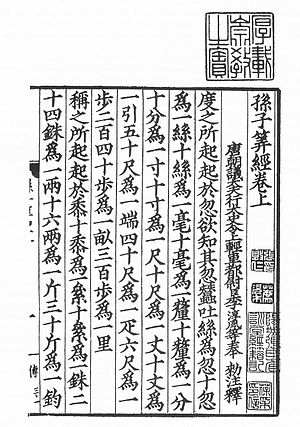Sunzi Suanjing(Chinese:Tôn tử tính kinh;pinyin:Sūnzǐ Suànjīng;Wade–Giles:Sun Tzu Suan Ching;lit.'The Mathematical Classic of Master Sun/Master Sun's Mathematical Manual') was a mathematicaltreatisewritten during 3rd to 5th centuries CE which was listed as one of theTen Computational Canonsduring theTang dynasty.The specific identity of its author Sunzi (lit."Master Sun" ) is still unknown but he lived much later than his namesakeSun Tzu,author ofThe Art of War.From the textual evidence in the book, some scholars concluded that the work was completed during theSouthern and Northern Dynasties.[2]Besides describing arithmetic methods and investigatingDiophantine equations,the treatise touches uponastronomyand attempts to develop acalendar.[citation needed]

Contents
editThe book is divided into three chapters.
Chapter 1
editChapter 1 discusses measurement units of length, weight and capacity, and the rules ofcounting rods.Although counting rods were in use in theSpring and Autumn periodand there were many ancient books on mathematics such asBook on Numbers and ComputationandThe Nine Chapters on the Mathematical Art,no detailed account of the rules was given. For the first time,The Mathematical Classic of Sun Ziprovided a detail description of the rules of counting rods: "one must know the position of the counting rods, the units are vertical, the tens horizontal, the hundreds stand, the thousands prostrate",[3]followed by the detailed layout and rules for manipulation of the counting rods in addition, subtraction, multiplication, and division with ample examples.
Chapter 2
editChapter 2 deals with operational rules for fractions with rod numerals: the reduction, addition, subtraction, and division of fractions, followed by mechanical algorithm for theextraction of square roots.[4]
Chapter 3
editChapter 3 contains the earliest example of theChinese remainder theorem,a key tool to understanding and resolvingDiophantine equations.
Bibliography
editResearchers have published a full English translation of theSūnzĭ Suànjīng:
- Fleeting Footsteps; Tracing the Conception of Arithmetic and Algebra in Ancient China,byLam Lay Yongand Ang Tian Se, Part Two, pp 149–182. World Scientific Publishing Company; June 2004ISBN981-238-696-3
The original Chinese text is available on Wikisource.
External links
editReferences
edit- ^Lam Lay Yongand An Tian Se. "Fleeting Footsteps", p. 4. World Scientific.ISBN981-02-3696-4.
- ^For instance, in problem 33 of volume 3, it is written, "Luoyang is 900 li away from Chang'an". As the name "Chang'an" was first employed during theHan dynasty,this work could not have been written before the 3rd century. Additionally, in problem 3 of volume 3, Sun Tzu writes "We have a board game, 19 rows and 19 columns square. Question: how many stones are there?" Sincegomade its first appearance in the mid-3rd century, the work was most probably written during theWeiorJindynasties.[1]
- ^Lam Lay Yongand An Tian Se, Fleeting Footsteps p55,World Scientific,ISBN981-02-3696-4
- ^Lam Lay Yongand An Tian Se, Fleeting Footsteps p65,World Scientific,ISBN981-02-3696-4